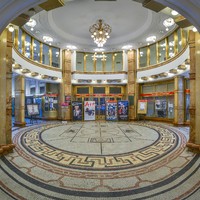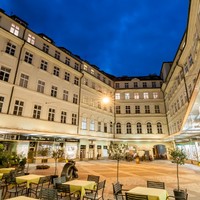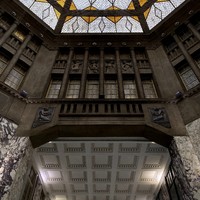Breadcrumbs navigation
Prague Arcades
We pass along these covered walkways time after time, shortening our routes, hiding from bad weather. But few know their original purpose.
Pasáž Koruna arcade
An unmistakable geometric walkway with elements of late Art Nouveau connects the lower part of Wenceslas Square and Na Příkopě street. This timeless work by Matěj Blecha and Antonín Pfeifer has always found a whole gamut of uses. Today, it serves primarily for commerce. The original house, whose history goes back to the 14th century, successfully resisted development until 1911, when it was demolished and construction of the magnificent Koruna Palace began. This, one of the earliest reinforced concrete buildings in Prague, still retains its original core and notable architectural décor.
Come the year 1985, instead of the B line of the Metro we find here public baths and a cinema. Yes, you read that right. The baths were closed to the public in 1975.At that time, the baths were lit by ambient light coming in through a dome onto a glazed floor of glass and concrete. The dome not only let light into the hall and pool, but also served to ventilate, and was supposed to vent any smoke in the event of a fire. The current dome is a copy of the original from the 1980s.
There also used to be a café and a gallery here, by the architect Ladislav Machoň, which was replaced in 1931, inspired by Berlin, by the first self-service eatery in Czechoslovakia. Sadly, you won’t find that here either any more, but it is worth noting that it was here that the popular Czech cold cuisine treat known as the ‘Russian egg’ first saw the light of day.
Palác U Stýblů (Alfa)
This seven-storey Functionalist building at the lower end of Wenceslas Square is now a protected cultural heritage monument. The name derives from the original owner and publisher, Václav Stýblo. The modern reinforced concrete building sprang up in place of two low-rise buildings between1928 and 1929 to the design of an architectural duo, Ludvík Kysela and Jan Jarolím. The walkway here is definitely worth noting for its unusual and unmistakable vault with a glass ceiling pleasantly letting through daylight, its shape resembling an overturned boat.
An arcade or just a short-cut?
This is where the Boulevard café used to be, later called Alfa, which, with its 900 square metres was the largest café in Prague at the time. In 1934, a low-rise annex housed the theatre and ensemble of Oldřich Nový, then a Czech film star. In the 1960s, the legendary Semafor Theatre was founded here, still commemorated by a sign on the wall, visible from the adjacent Franciscan Garden. It was here until the early 1990s, when the palazzo ceased to function as a lively social centre. Today, the arcade passageway serves mainly as a connection between Wenceslas Square and the Franciscan Garden, or going through the adjacent Světozor passage to Vodičkova street.
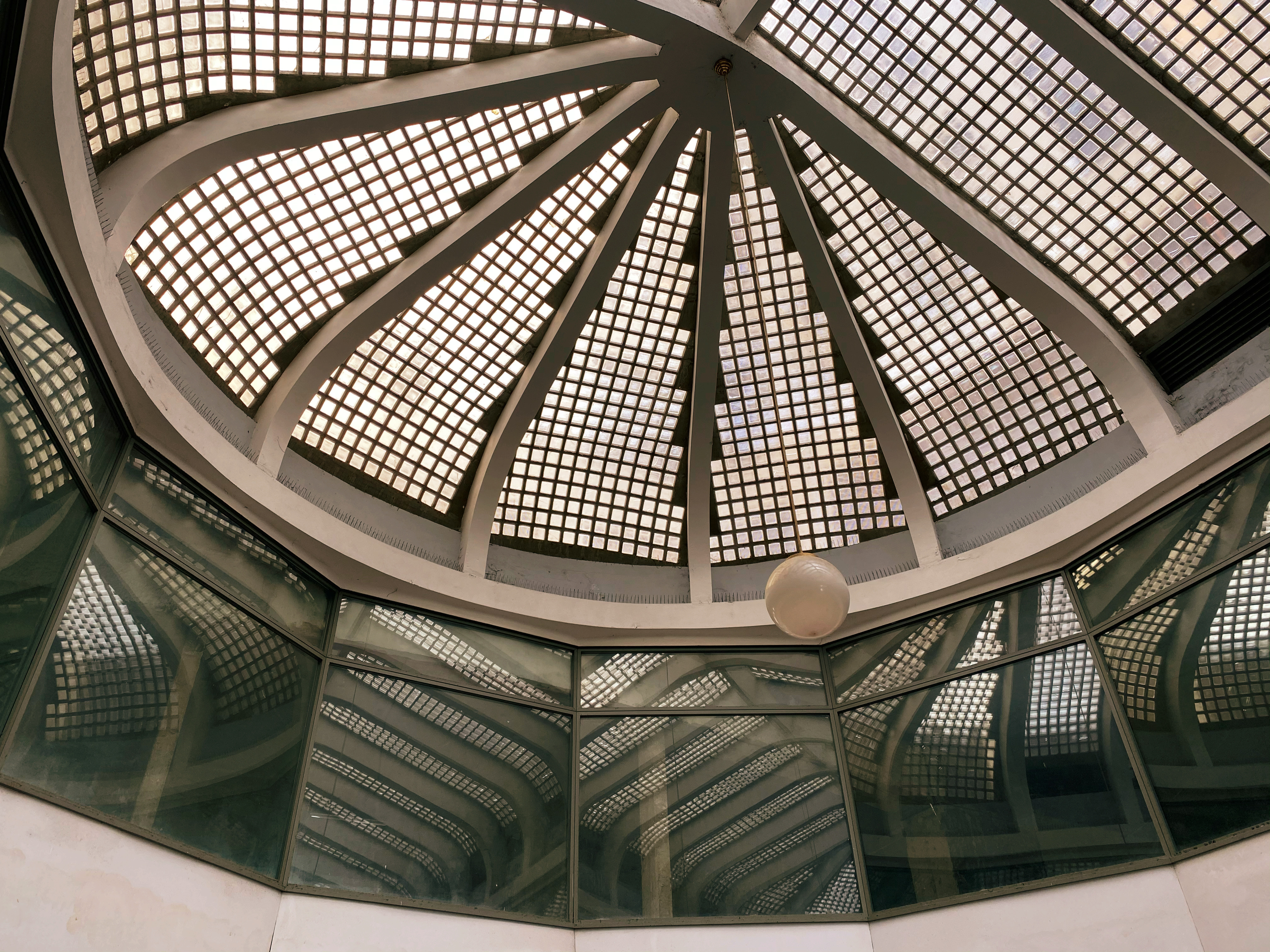
An Arcade of Czech design
The arcade leading through the Czech National Bank, formerly Crop Exchange building in Na Příkopě street is not one to pass through without stopping. Its main purpose was to connect the city centre and the Main Railway Station, but broadened its scope more recently. The large shop windows along one side of it give passers-by a showcase of the best works by contemporary Czech designers.
The project’s realization was hampered by the Great Depression, setting it back to 1935. The authors of the project was architect František Roith and his pupil Otto Wagner. The bank building was built on the site where the Black Horse Hotel used to stand. At the time it was the most modern and also the most opulent banking palace in Czechoslovakia.
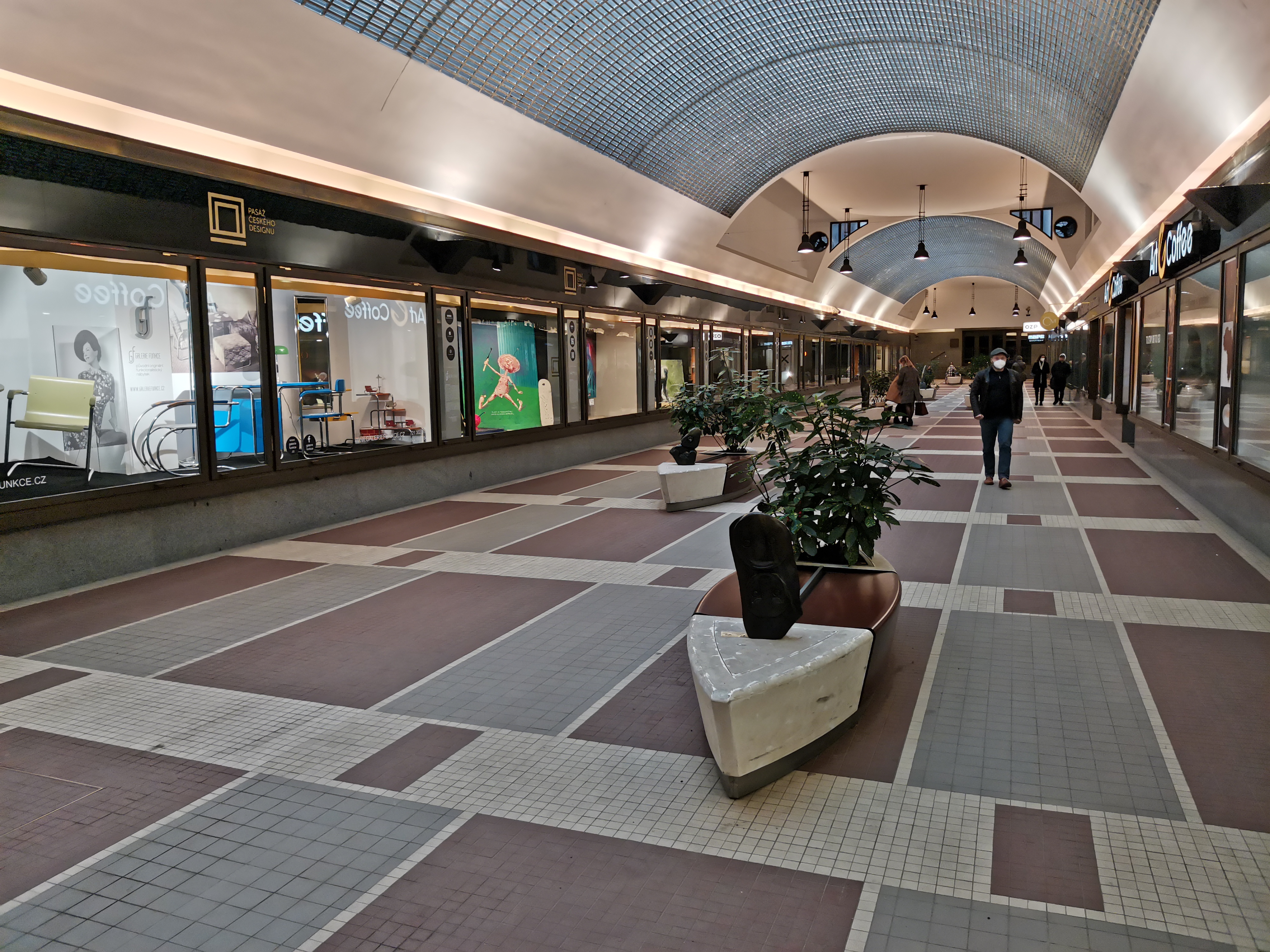
Adria Palace and its namesake arcade passage
Few people know that the palazzo was originally built for the Italian insurance company Riunione Adriatica di Sicurta, whose name it bears to this day. The Rondo-cubic (Czech oblong Cubist style) building by architect Josef Zasch with a façade by Pavel Janák was created between 1923 and 1924 and is an important modern architectural landmark. The façade captivates the gaze with its rich sculptural decoration by Josef Malínský, and the frontage of the palazzo on Národní třída street is decorated with a metal statue of Adria (symbolizing seafaring), crafted by Jan Josef Štursa. Inside the building, you’ll note not only the pink marble, brought in from the Austrian Alps, but also the mosaic floors with motifs related to insurance – boats, locomotives, and a house on fire. The palazzo has a circular atrium hall and a glass-ceiling gallery that lets in daylight. In the hall you will not fail to notice the large clock by Bohumil Kafka with its rich sculptural decorations. You will find allegorical figures of Day and Night, the Sun and the Moon, as well as the twelve signs of the Zodiac.
Lucerna Palace
Lucerna Palace near Wenceslas Square stands witness to the beginnings of Czech modernism, though its eclectic design bears traces of late Art Nouveau. When completed in 1921, it became the most visited social centre of the city. This was, however, not in the lifetime of its builder, designer and entrepreneur ing. Vácslav Havel, the grandfather of President Václav Havel; his bust adorns the staircase.
A major draw was the then first mall thoroughfare in the metropolis, today featuring the provocative suspended equestrian statue of the Czech patron St Wenceslas, by David Černý. The passage connects Vodičkova with Štěpánská street. Leading off to one side is also the Rokoko passage, which takes you to Wenceslas Square and the U Nováků passage. This intricate network of passageway arcades creates its own pleasant space for a whole host of social activities, following on from their wealth of history. In what is now the popular Lucerna bar, there used to be a cabaret, highly acclaimed among the best jazz musicians of interwar Europe. The Lucerna cinema came to feature Prague’s first audio cinematograph. The large dance and meeting hall was the technical wonder of its time, with its reinforced concrete structure anchored on a concrete slab recessed fourteen metres underground. The Lucerna great hall, before and after the war, hosted many musical legends; Josephine Baker danced and Louis Armstrong and Count Basie played here. During the occupation it resounded with Nazi rhetoric. Also worth a mention is the Lucerna Café on the first floor of the passage, where you can enjoy great coffee and a great choice of delicious desserts. Sometimes, you can even get to dance an Argentine tango here. Quite a building, and no mistake!

Světozor arcade
Just opposite the Lucerna Palace is the Ligna Palace, formerly the Czech Bank Palace, built between 1914 and 1918. Transecting the palace is the Světozor [World-view] arcade, with its glass roof, with exits to Vodičkova street, the Franciscan Garden or connecting through to the Alfa passageway in the adjacent palazzo U Stýblů. Catching the eye at first glance is a large mosaic logo of the Czechoslovak company Tesla.
This arcade is especially popular because of the Světozor cinema and the adjacent renowned Ovocný Světozor [Fruit World-view] confectionery. The three-screen art cinema with a penchant for creative film-making is also English friendly, by the way. The Great Hall features premières of Czech and world art films, reruns of previously shown blockbusters and exclusive screenings. The smaller screening rooms are mostly designated for documentaries, experimental and animated films. The cinema is also known as a festival cinema, as it organizes and hosts a number of film shows during the year. One of its regular events is La Película, a festival of Spanish films. The cinema premises also include a gallery shop called ‘Terry Posters’ specializing in movie posters. To follow your cultural experience, do not miss out on the fabulous desserts, sandwiches or ice creams in the Ovocný Světozor café.

Platýz arcade
On Národní třída street stands Palác Platýz, with a shopping arcade, pleasant cafés, an auction gallery and probably the earliest traffic signal in Prague, over two hundred years old. The palazzo boasts some very interesting history, having had a number of notable owners. Friedrich of Burgundy, a member of the court of Charles IV, converted the houses on this site into the first palace. Václav Hájek from Libočany writes about him in his chronicle. Yet the palace takes its name after the imperial counsel and secretary to Rudolf II, who bought it in the 16th century. His name was Jan Platais (Platejs) of Plattenstein.
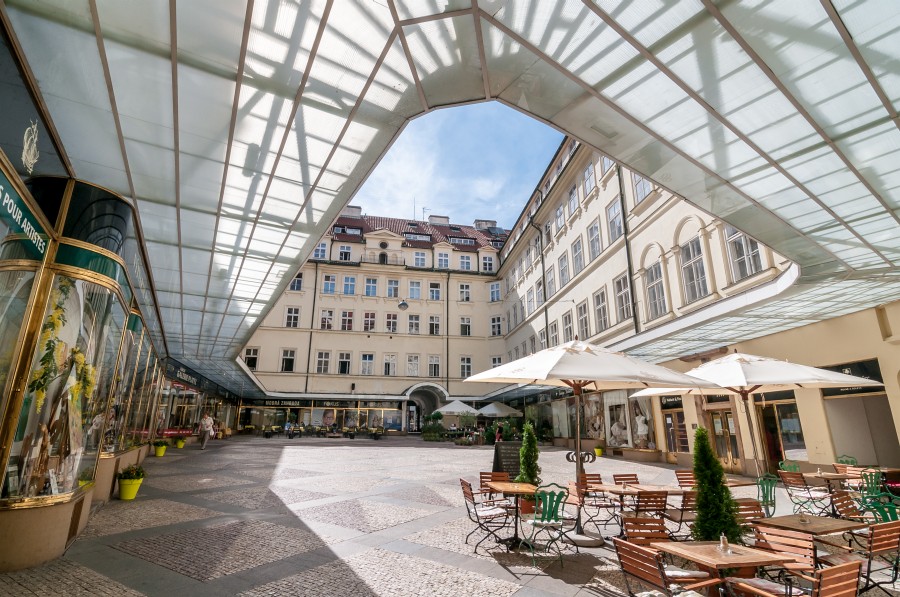
It was only during the Šternberk period in the 17th century and the Baroque modifications of the building that the Národní třída and Coal Market connecting passage was built. This also included a hostelry for travellers and the site was a vibrant cultural venue. Particular renown was enjoyed by the local fencing school. Ostensibly the earliest traffic signpost dates from this period. It is a small owlet, situated at the Národní třída entrance. The owlet’s stance used to designate whether a coachman would find a parking space inside. When the owlet sat with its head up, you were welcome to enter. If it was hanging upside down, it meant that all the spaces were taken and entry was barred. Today, the palazzo with its passageway is a relaxing and peaceful spot of calm in the heart of Prague. The business premises here offer a variety of goods, with e.g. the well-known ‘Golden Ship’ emporium offering art materials. A few steps further along is the popular Café Platýz, with a range of food and drinks. The building is mostly residential, but also houses a kindergarten.

